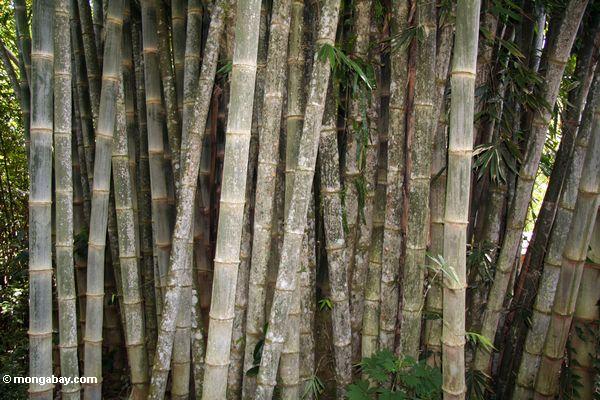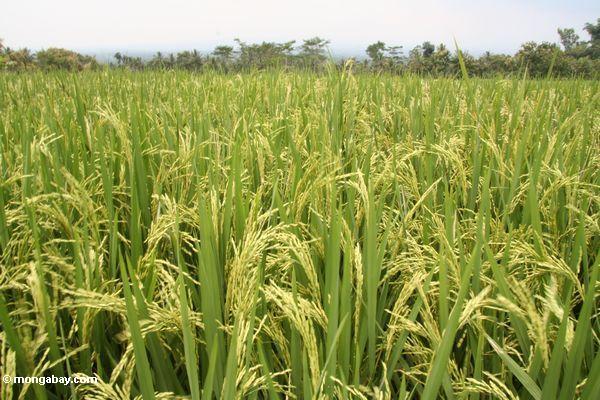Benefits of Biodiversity
APPRECIATING THE BENEFITS OF PLANT BIODIVERSITY
By John Tuxill
From "State of the World, 1999." Copyright í 1999, Worldwatch Institute. Publication is available from Worldwatch Institute, 1776 Massachusetts Avenue, N.W., Washington, D.C. 20036. http://www.worldwatch.org

Rainforest in Borneo. All photos courtesy of Mongabay.com
At first glance, wild potatoes are not too impressive. Most are thin-stemmed, rather weedy-looking plants that underground bear disappointingly small tubers. But do not be deceived by initial appearances, for these plants are key allies in humankind's ongoing struggle to control late blight, a kind of fungus that thrives on potato plants. It was late blight that, in the 1840s, colonized and devastated the genetically uniform potato fields of Ireland, triggering the infamous famine that claimed more than a million lives. The disease has been controlled this century largely with fungicides, but in the mid-1980s farmers began reporting outbreaks of fungicide-resistant blight. These newly virulent strains have cut global potato harvests in the 1990s by 15 percent, a $3.25 billion [thousand-million] yield loss; in some regions, such as the highlands of Tanzania, losses to blight have approached 100 percent. Fortunately, scientists at the International Potato Center in Lima, Peru, have located genetic resistance to the new blight strains in the gene pools of traditional Andean potato cultivars and their wild relatives, and now see hope for reviving the global potato crop.
Wild potatoes are but one manifestation of the benefits humans gain from biological diversity, the richness and complexity of life on Earth. Plant biodiversity, in particular, is arguably the single greatest resource that humankind has garnered from nature during our long cultural development. Presently, scientists have described more than 250,000 species of mosses, ferns, conifers, and flowering plants, and estimate there may be upwards of 50,000 plant species yet to be documented, primarily in the remote, little-studied reaches of tropical forests.
Within just the hundred-odd species of cultivated plants that supply most of the world's food, traditional farmers have selected and developed hundreds of thousands of distinct genetic varieties. During this century, professional plant breeders have used this rich gene pool to create the high-yielding crop varieties responsible for much of the enormous productivity of modern farming. Plant diversity also provides oils, latexes, gums, fibers, dyes, essences, and other products that clean, clothe, and refresh us and that have many industrial uses. And whether we are in the 20 percent of humankind who open a bottle of pills when we are feeling ill, or in the 80 percent who consult a local herbalist for a healing remedy, a large chunk of our medicines comes from chemical compounds produced by plants.

Butterfly in Costa Rica. Photo courtesy of mongabay.com
Yet the more intensively we use plant diversity, the more we threaten its long-term future. The scale of human enterprise on Earth has become so great -- we are now nearly 6 billion strong and consume about 40 percent of the planet's annual biological productivity -- that we are eroding the very ecological foundations of plant biodiversity and losing unique gene pools, species, and even entire communities of species forever. It is as if humankind is painting a picture of the next millennium with a shrinking palette -- the world will still be colored green, but in increasingly uniform and mono-cultured tones. Of course, our actions have produced benefits: society now grows more food than ever before, and those who can purchase it have a material standard of living unimaginable to earlier generations. But the undeniable price that plant diversity and the ecological health of our planet are paying for these achievements casts a shadow over the future of the development path that countries have pursued this century. To become more than a short-term civilization, we must start by maintaining biological diversity.

Colombia
INTO THE MASS EXTINCTION
Extinction is a natural part of evolution, but it is normally a rare and obscure event; the natural or "background" rate of extinction appears to be about 1-10 species a year. By contrast, scientists estimate that extinction rates have accelerated this century to at least 1,000 species per year. These numbers indicate we now live in a time of mass extinction -- a global evolutionary upheaval in the diversity and composition of life on Earth.
Paleontologists studying Earth's fossil record have identified five previous mass extinction episodes during life's 1.5 billion years of evolution, with the most recent being about 65 million years ago, at the end of the Cretaceous period, when the dinosaurs disappeared. Earlier mass extinctions hit marine invertebrates and other animal groups hard, but plants weathered these episodes with relatively little trouble. Indeed, flowering plants, which now account for nearly 90 percent of all land plant species, did not begin their diversification until the Cretaceous -- relatively recently, in evolutionary terms.

Sulawesi
In the current mass extinction, however, plants are suffering unprecedented losses. According to a 1997 global analysis of more than 240,000 plant species coordinated by the World Conservation Union-IUCN, one out of every eight plants surveyed is potentially at risk of extinction. This tally includes species already endangered or clearly vulnerable to extinction, as well as those that are naturally rare (and thus at risk from ecological disruption) or extremely poorly known. More than 90 percent of these at-risk species are endemic to a single country -- that is, found nowhere else in the world.
The United States, Australia, and South Africa have the most plant species at risk, but their high standing is partly due to how much better-known their flora is compared with that of other species-rich countries. We have a good idea of how many plants have become endangered as the coastal sage scrub and perennial grasslands of California have been converted into suburban homes and cropland, for example. But we simply do not know how many species have dwindled as the cloud forests of Central America have been replaced by coffee plots and cattle pastures, or as the lowland rainforests of Indonesia and Malaysia have become oil palm and pulpwood plantations.

Chopping down rainforest for oil palm in Malaysia
Increasingly, it is not just individual species but entire communities and ecosystems of plants that face extinction. The inter-Andean laurel and oak forests of Colombia, the heath-lands of western Australia, the seasonally dry forest of the Pacific island of New Caledonia -- all have been largely overrun by humankind. In the southeast corner of Florida in the United States, native plant communities, such as subtropical hardwood hammocks and limestone ridge pinelands, have been reduced to tiny patches in a sea of suburban homes, sugarcane fields, and citrus orchards. These irreplaceable remnants are all that is left of what southeast Florida once was -- and they are now held together only with constant human vigilance to beat back a siege of exotic plants, such as Brazilian pepper and Australian casuarina.
Biodiversity is also lost when gene pools within species evaporate. The closest wild ancestor of corn is a lanky, sprawling annual grass called teosinte, native to Mexico and Guatemala, where it occurs in eight separate populations. Botanist Garrison Wilkes of the University of Massachusetts regards seven of these populations as rare, vulnerable, or already endangered -- primarily due to the abandonment of traditional agricultural practices and to increased livestock grazing in the field margins and fallow areas favored by teosinte. Overall, teosinte is not yet threatened with extinction. But because the plant hybridizes readily with domesticated corn, every loss of a unique teosinte population reduces genetic diversity that may one day be needed to breed better-adapted corn plants.

Colombia
OF FOOD AND FARMERS
Nowhere is the value of biodiversity more evident than in our food supply. Roughly one third of all plant species have edible fruits, tubers, nuts, seeds, leaves, roots, or stems. During the nine tenths of human history when everyone lived as hunter-gatherers, an average culture would have had knowledge of several hundred edible plant species that could provide sustenance. Today, wild foods continue to supplement the diet of millions of rural poor worldwide, particularly during seasonal periods of food scarcity. Tuareg women in Niger, for instance, regularly harvest desert panic-grass and shama millet while migrating with their animal herds between wet and dry-season pastures. In rural northeast Thailand, wild foods gathered from forests and field margins make up half of all food eaten by villagers during the rainy season. In the city of Iquitos in the Peruvian Amazon, fruits of nearly 60 species of wild trees, shrubs, and vines are sold in the city produce markets. Residents in the surrounding countryside are estimated to obtain a tenth of their entire diet from wild-harvested fruits.

Kenya
For the last 5-10 millennia, we have actively cultivated the bulk of our food. Agriculture arose independently in many different regions, as people gradually lived closer together, became less nomadic, and focused their food production on plants that were amenable to repeated sowing and harvesting. In the 1920s, the legendary Russian plant explorer Nikolai Vavilov identified geographic centers of crop diversity, including Mesoamerica, the central Andes, the Mediterranean Basin, the Near East, highland Ethiopia, and eastern China. He also inferred correctly that most centers correspond to where crops were first domesticated. For instance, native Andean farmers not only brought seven different species of wild potatoes into cultivation, they also domesticated common beans, lima beans, passion fruit, quinoa and amaranths (both grains), and a host of little-known tuber and leaf crops such as oca, ulluco, and tarwi -- more than 25 species of food plants in all.
Over the millennia, farmers have developed a wealth of distinctive varieties within crops by selecting and replanting seeds and cuttings from uniquely favorable individual plants -- perhaps one that matured slightly sooner than others, was unusually resistant to pests, or possessed a distinctive color or taste. Subsistence farmers have always been acutely attentive to such varietal diversity because it helps them cope with variability in their environment, and for most major crops, farmers have developed thousands of folk varieties, or "landraces." India alone, for instance, probably had at least 30,000 rice landraces earlier this century.

Rice in Java
On-farm crop selection remains vital in developing countries, where farmers continue to save 80-90 percent of their own seed supplies. In industrial nations, by contrast, the seed supply process has become increasingly centralized during this century, as professional plant breeders have taken up the job of crop improvement and as corporations have assumed responsibility for supplying seeds. The power and promise of scientifically based plant breeding was confirmed by the 1930s, when the first commercial hybrid corn was marketed by the Pioneer Hi-Bred Company. Hybrids are favored by seed supply companies because they tend to be especially high-yielding (the bottom line for commercial farming) and because "second-generation" hybrid seeds do not retain the traits of their parents. This means that farmers must purchase hybrid seed anew from the supplier rather than saving their own stock. Some farmers have also been legally disenfranchised from seed-saving; under European Union law, it is now illegal for farmers to save and replant seed from plant varieties that have been patented by breeders.
Although farmers can now purchase and plant seeds genetically engineered with the latest molecular techniques, the productivity of our food supply still depends on the plant diversity maintained by wildlands and traditional agricultural practices. Wild relatives of crops continue to be used by breeders as sources of disease resistance, vigor, and other traits that produce billions of dollars in benefits to global agriculture. Imagine giving up sugarcane, strawberries, tomatoes, and wine grapes; none of these crops could be grown commercially without the genetic contribution of their respective wild relatives. With the rescue mission of their wild kin now under way, we can also place potatoes on this list.
Next






